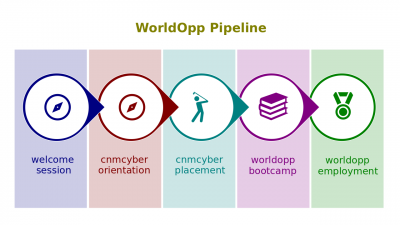Difference between revisions of "Personalities and Work"
(→Script) |
|||
| (28 intermediate revisions by 2 users not shown) | |||
| Line 1: | Line 1: | ||
[[Personalities and Work]] (hereinafter, the ''Lectio'') is the second [[lectio|lesson part]] of the '''[[Nature of Occupations]]''' [[lesson]] that introduces its participants to [[occupation]]s and related topics. | [[Personalities and Work]] (hereinafter, the ''Lectio'') is the second [[lectio|lesson part]] of the '''[[Nature of Occupations]]''' [[lesson]] that introduces its participants to [[occupation]]s and related topics. | ||
| − | [[File:Educaship-pipeline.png|400px|thumb|[[WorldOpp Pipeline]]]]This ''lesson'' belongs to the [[Introduction to Employment]] session of | + | [[File:Educaship-pipeline.png|400px|thumb|[[WorldOpp Pipeline]]]]This ''lesson'' belongs to the [[Introduction to Employment]] session of [[EmployableU Concepts]]. |
| Line 7: | Line 7: | ||
The predecessor [[lectio]] is [[What Occupation Is]]. | The predecessor [[lectio]] is [[What Occupation Is]]. | ||
| − | === | + | ===Script=== |
| − | :[[ | + | :For a long time, [[psychologist]]s have been approaching various ideas to match [[personality|personaliti]]es and [[occupation]]s. Logically, [[artist]]s tend to be more disruptive ''personalities'' than [[accountant]]s. Vice versa, ''accountants'' tend to be more conforming ''personalities'' than [[artist]]s. |
| − | |||
| − | + | :No single personality framework fully describes a ''personality'' and no one can predict one's [[productivity]] at the workplace depending on the ''personality'' only. There might be no need. A successful sport team, for instance, should be a mosaic of ''personalities'' regardless of the fact that all of them would share the same ''occupation''. | |
| − | : | ||
| − | : | + | :The [[Myers-Briggs Type Indicator]] ([[Myers-Briggs Type Indicator|MBTI]]) was originally developed to identify students' aptitudes toward various [[profession]]s. Today, some [[employer]]s collect [[Myers-Briggs Type Indicator|MBTI]] data to match [[mentor]]s and [[protégé]]s. |
| − | : | + | :This [[personality test]] taps four characteristics and classifies people into one of 16 personality types. |
:Every characteristic contributes one letter from the following pairs: | :Every characteristic contributes one letter from the following pairs: | ||
| − | :* | + | :*First letter is either '''E''' for [[Extraversion]] or '''I''' for [[Intraversion]] depending on onward or inward focus, |
| − | :* | + | :*Second letter is either '''S''' for [[Sensing]] or '''N''' for [[Intuition]] in acquiring information, |
| − | :* | + | :*Third letter is either '''T''' for [[Thinking]] or '''F''' for [[Feeling]] in making decisions, |
| − | :* | + | :*Last, fourth letter is either '''J''' for [[Judging]] or '''P''' for [[Perceiving]] in living outer life. |
| − | :For instance, '' | + | :For instance, ''ISFP'' would stand for a ''sensing, feeling, perceiving introvert''. |
| + | |||
| + | :In another attempt, American psychologist John Holland matched two [[personality dimension]]s, disruptive versus conforming and individual versus collective, with six groups of ''occupations''. Holland's groups are [[artistic occupation|artistic]], [[conventional occupation|conventional]], [[enterprising occupation|enterprising]], [[investigative occupation|investigative]], [[realistic occupation|realistic]], and [[social occupation|social]]. | ||
| − | : | + | :This model is called the [[Holland Occupational Themes]]. The [[Occupational Information Network]] utilizes this model in its [[occupational interest|Interest]]s section. |
| + | |||
| + | ===Key terms=== | ||
| + | :[[Personality]], [[Myers-Briggs Type Indicator]] ([[Myers-Briggs Type Indicator|MBTI]]) | ||
| − | : | + | ===Closing=== |
| + | :Have you ever taken the [[Myers-Briggs Type Indicator]] ([[Myers-Briggs Type Indicator|MBTI]]) or any other [[personality test]]? --Yes/No/Let's move on for now | ||
| − | + | '''[[Occupational Interests]]''' is the successor [[lectio]]. | |
| − | + | ==Questions== | |
| − | == | + | ===Placement entrance exam=== |
Latest revision as of 20:51, 29 October 2023
Personalities and Work (hereinafter, the Lectio) is the second lesson part of the Nature of Occupations lesson that introduces its participants to occupations and related topics.
This lesson belongs to the Introduction to Employment session of EmployableU Concepts.
Content
The predecessor lectio is What Occupation Is.
Script
- For a long time, psychologists have been approaching various ideas to match personalities and occupations. Logically, artists tend to be more disruptive personalities than accountants. Vice versa, accountants tend to be more conforming personalities than artists.
- No single personality framework fully describes a personality and no one can predict one's productivity at the workplace depending on the personality only. There might be no need. A successful sport team, for instance, should be a mosaic of personalities regardless of the fact that all of them would share the same occupation.
- The Myers-Briggs Type Indicator (MBTI) was originally developed to identify students' aptitudes toward various professions. Today, some employers collect MBTI data to match mentors and protégés.
- This personality test taps four characteristics and classifies people into one of 16 personality types.
- Every characteristic contributes one letter from the following pairs:
- First letter is either E for Extraversion or I for Intraversion depending on onward or inward focus,
- Second letter is either S for Sensing or N for Intuition in acquiring information,
- Third letter is either T for Thinking or F for Feeling in making decisions,
- Last, fourth letter is either J for Judging or P for Perceiving in living outer life.
- For instance, ISFP would stand for a sensing, feeling, perceiving introvert.
- In another attempt, American psychologist John Holland matched two personality dimensions, disruptive versus conforming and individual versus collective, with six groups of occupations. Holland's groups are artistic, conventional, enterprising, investigative, realistic, and social.
- This model is called the Holland Occupational Themes. The Occupational Information Network utilizes this model in its Interests section.
Key terms
Closing
- Have you ever taken the Myers-Briggs Type Indicator (MBTI) or any other personality test? --Yes/No/Let's move on for now
Occupational Interests is the successor lectio.
